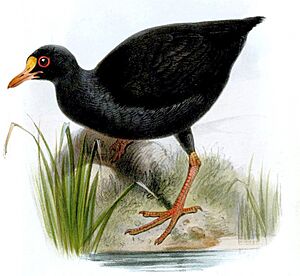Samoan woodhen facts for kids
Quick facts for kids Samoan woodhen |
|
|---|---|
 |
|
| Drawing by Joseph Smit | |
| Conservation status | |
| Scientific classification | |
| Genus: |
Gallinula
|
| Species: |
pacifica
|
| Synonyms | |
|
Gallinula pacificus (lapsus) |
|
The Samoan woodhen, also called the Samoan wood rail, was a special bird that lived only on the island of Savai'i in Samoa. It was a type of rail, a group of birds that often live near water. This bird was almost unable to fly. Sadly, it is now considered Critically Endangered, meaning it is at a very high risk of disappearing forever.
Local Samoans called this bird puna'e, which means "one that jumps up." This name came from how the bird would quickly jump and dash into hiding when it was surprised.
About the Samoan Woodhen
The Samoan woodhen was a small bird, about 25 centimeters (10 inches) long. Its head, neck, and chest were a dark blue color. The back and tail were completely black. The upper parts of its body were a dark olive green with a shiny look.
Its beak and a special shield-like part on its forehead were yellowish to orange-red. The bird's eyes and legs were also red.
Life and Habits
The Samoan woodhen likely had large eyes because it was active mostly at night. It lived in the thick, old forests on the mountains.
This bird ate insects and other small creatures without backbones. It would dig in the ground and through fallen leaves to find its food. Scientists found that if these birds were kept in captivity and only given plants to eat, they would get sick.
People thought the Samoan woodhen laid its eggs in nests on the ground, made from twigs and grass. However, some local people said the puna'e nested in burrows, which are like small tunnels in the ground. It's possible they might have confused the bird with other burrow-nesting birds like petrels.
Why the Samoan Woodhen Disappeared
The Samoan woodhen was first seen by a scientist named John Stanislaw Kubary in 1869. The last time a specimen was collected was in 1873 during a British science trip called the Challenger expedition. Today, there are only about ten or eleven Samoan woodhen specimens and one or two eggs left in museums around the world.
It seems the Samoan woodhen became extinct in the 1870s. This was mainly because of new animals brought to the island, like rats and wild cats, which hunted the birds. People also hunted the woodhen for food because it was said to taste good.
Even though it was thought to be gone, there were a few unconfirmed sightings of a bird that might have been the Samoan woodhen. People reported seeing it in the rainforests in 1984 and again in 2003. In 2003, a deep, gulping sound was heard that didn't match other known birds on the island. Scientists hope to do more research to find out if this special bird is still out there.
See also
- Central Savai'i Rainforest


